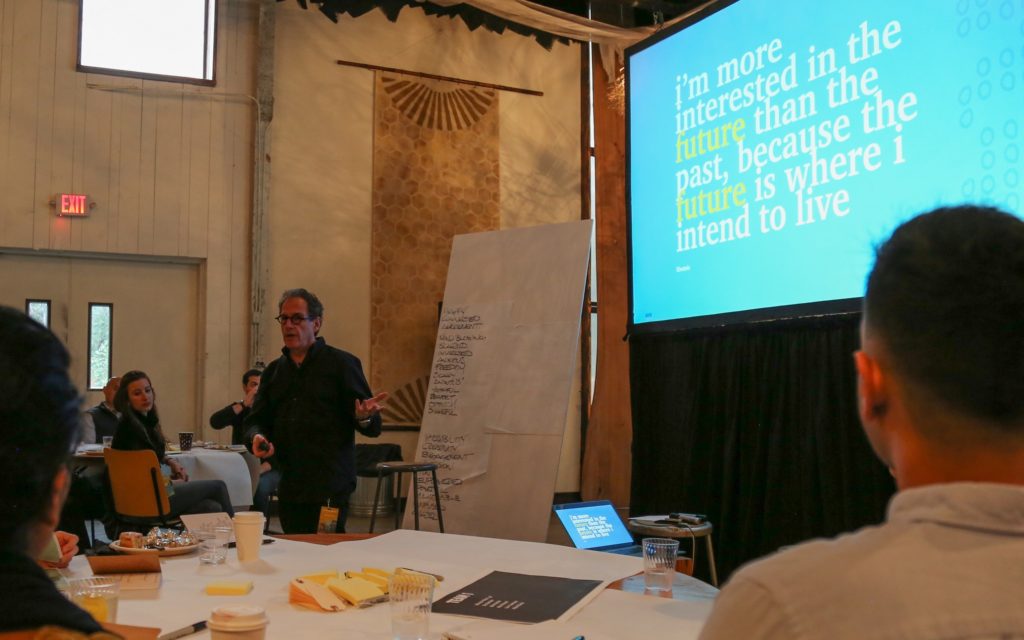Building a Better Human-Tech Paradigm by 2023
This blog is the second in a series exploring our evolving thinking on the relationships between technology and society. We look forward to learning more about this emerging topic, and to sharing what we learn along the way.
How can we harness the power of tech?
As we built robust programs in social and emotional learning and digital learning, we have asked ourselves this question countless times. Technology is everywhere. The line between online and offline life is fading fast. Tech’s power is undeniable; its effect on our individual and collective well-being is trickier to grasp.
In the first article in this series, we explored how the intersection of our SEL and Digital Learning program areas led us to build a new program: Tech and Society. We launched this program with a lot of questions and few answers. We knew we wouldn’t be able to find those answers on our own. So shortly after announcing this program, we began planning a convening of the best and brightest minds who shared our desire for a world both plugged-in and productive.
Our intent? To surface all of our experiences with tech, both the good and the bad, and draw from them to collectively envision a better future.
To plan this convening, we partnered with Spark’s Jim Cohen and Solon Teal, professional facilitators with extensive backgrounds in technology, business, and human-centered design. From the beginning, Jim and Solon challenged us to think creatively about who qualified as an “expert.” In order to make this convening truly matter, they cautioned, we needed to consider those with nontraditional but equally important views on tech.
Our convening quickly grew beyond the gathering of grant partners and researchers we had originally envisioned. In January of this year, we flew to Austin with twenty-six teachers, artists, academics, storytellers, nonprofit leaders, designers, and high school students—each of whom brought a unique and important perspective to the table.

Before touching down in Texas, we presented our convening participants with a challenge: How can we advance our current human-technology paradigm in three years?
It’s a huge question, and we had just a day and a half to address it. The pressure was on.
Jim and Solon kicked things off with an exercise where each of us shared our first memory of technology and how that experience made us feel. It was quite a trip down memory lane; we told stories about everything from landlines and VCRs to YouTube and Instagram. Even more interesting were the emotions associated with these memories—joy and wonder on one hand, anxiety and fear on the other. Simple as it was, this exercise made the issue feel tangible and relevant. We left the room reflecting on how this issue affects each of us personally.
On day two, we got straight to business. Right away, Jim and Solon asked us to think backwards. “It’s 2023,” they posed, “We’ve built a more productive and positive paradigm for our relationships with technology. How did we get here?”
Working in small groups to backcast from this ideal future, we brainstormed projects that moved the needle, identified barriers that we overcame, selected a single great idea, and laid out a roadmap for how that solution helped us achieve our goal. We ended up with a mountain of foam core, more post-it notes than we know what to do with, and five road maps towards a better future.

Through this process, our small team generated a ton of great ideas. Now it’s on us to sort through these solutions and identify which ones we can turn into actionable projects.
But as the dust settled from the convening, a few core concepts began to emerge. Here are our biggest takeaways from this work.
- The status quo is complicated. Our current relationships with technology make us feel a wide range of emotions. We value how tech brings us connection, freedom, and possibility; we resent how it causes confusion, anxiety, and fear.
- A better future is possible. We could imagine a future where technology contributes to individual and collective well-being. That future embodies the ideals of purpose, optimism, inspiration, balance, empathy, and magic.
- Agency is important. Tech shouldn’t be in control of the human-tech paradigm—we should be. Solutions to build a better future must acknowledge and encourage this agency, empowering each of us to develop a personal relationship with the tech we use.
- Diversity matters. Many of our participants expressed gratitude for being part of such a diverse group. By bringing together unlikely actors, we heard perspectives that are rarely elevated and ideas that might not have been surfaced.
- Solutions must be holistic. Our tech-enabled society is immeasurably complex, and every stakeholder in the system has distinct motivations. Instead of building piecemeal solutions in silos, we must forge unlikely alliances to achieve a better future.
In the coming weeks, we’ll work with Jim and Solon to distill the wealth of information that came out of this convening into an actionable set of solutions. We look forward to sharing what comes out of this exercise. Stay tuned!

Photos © K Krunk Photo
